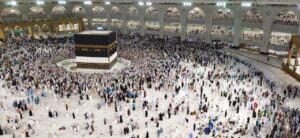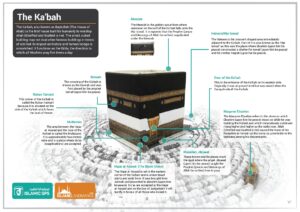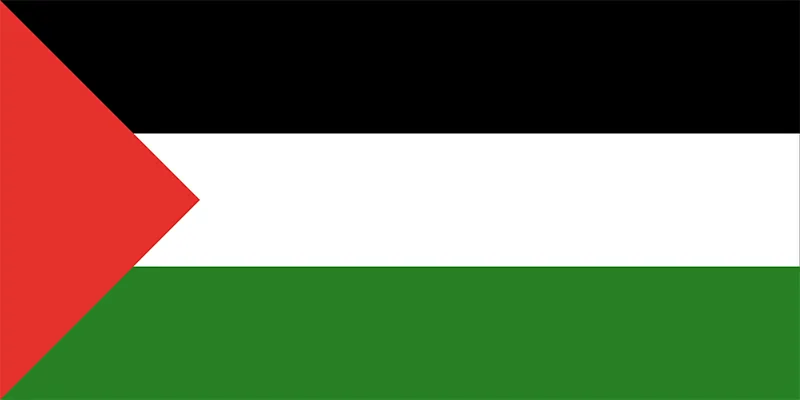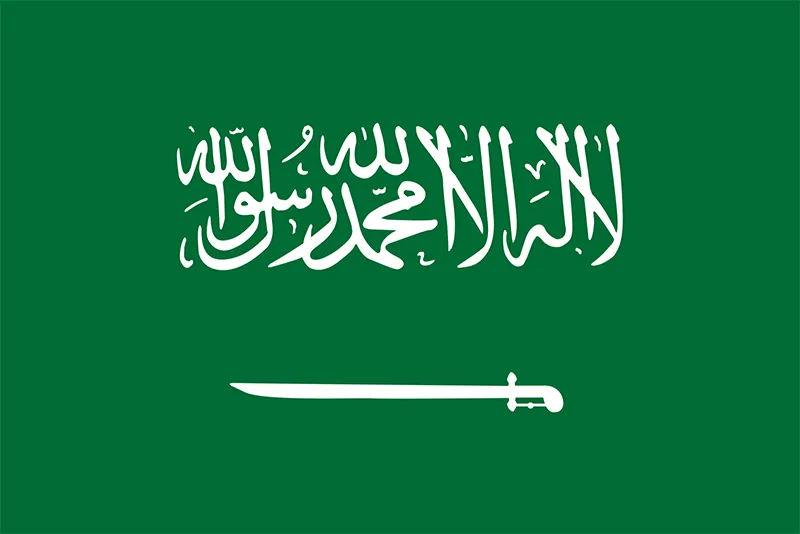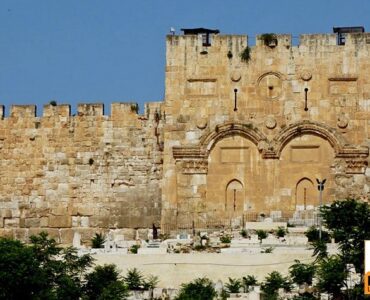The Kaaba holds immense significance to Muslims around the world for several reasons. Firstly, it is believed to be the holiest site in Islam. According to Islamic tradition, it was built by the Prophet Ibrahim (AS)and his son Ismail (AS) as a house of worship dedicated solely to the worship of the One God, Allah.
But why is the Kaaba important? The Kaaba in Mecca serves as the focal point for Muslims from all corners of the world. During their daily prayers, Muslims face towards the Kaaba, symbolising unity and the universality of Islam. It represents the spiritual center of Islam and is considered the “House of Allah.”
What is the Holy Kaaba in Islam?
The Holy Kaaba is a sacred structure in Islam. It is a cuboid building located in the city of Mecca, Saudi Arabia. Muslims consider it the most religious site in Islam and believe it was built by the Prophet Ibrahim (AS) and his son Ismail (AS) as the first house of worship dedicated to Allah.


The Kaaba serves as the focal point for Muslims’ prayers, as they face it during their daily prayers, symbolising unity and the oneness of Allah. It holds immense religious significance and is a central site for the annual Hajj Pilgrimage, and Umrah pilgrimage, where millions of Muslim pilgrims gather to perform rituals around the Kaaba.
Why is the Kaaba important to Muslims in Islam?
The Kaaba holds great importance to Muslims in Islam due to its historical and religious significance. It is believed to be the first house of worship dedicated to the worship of Allah, built by the Prophet Ibrahim (AS) and his son Ismail (AS).
The Kaaba serves as the focal point for Muslims’ prayers, as they face it during their daily prayers, symbolising unity and the oneness of Allah. It represents Islam’s spiritual center, embodying monotheism and devotion principles.
Moreover, the Holy Kaaba is the main site for the annual Hajj and Umrah, a fundamental pillar of Islam. Umrah and Hajj Pilgrims from all over the world gather in Mecca to perform Umrah and Hajj rituals around the Kaaba, reaffirming their faith and fostering a sense of community and equality among Muslims.
The Quran mentions the Kaaba and its significance in several verses. Here are a few Quranic verses that highlight the importance of the Kaaba:
Surah Al-Baqarah (2:125)
“And [mention] when We made the House a place of return for the people and [a place of] security. And take, [O believers], from the standing place of Abraham a place of prayer. And We charged Abraham and Ishmael, [saying], ‘Purify My House for those who perform Tawaf and those who are staying [there] for worship and those who bow and prostrate [in prayer].'”
Surah Al-Imran (3:96)
“Indeed, the first House [of worship] established for mankind was that at Makkah – blessed and a guidance for the worlds.”
Surah Al-Hajj (22:26-27)
“And [mention] when We designated for Abraham the site of the House, [saying], ‘Do not associate anything with Me and purify My House for those who perform Tawaf and those who stand [in prayer] and those who bow and prostrate. And proclaim to the people the Hajj [pilgrimage]; they will come to you on foot and on every lean camel; they will come from every distant pass.”
Why is the Kaaba important during Hajj and Umrah?
The Kaaba holds immense significance during Umrah and Hajj, the annual pilgrimage in Islam. It is an integral part of the rituals performed by millions of Muslims during this sacred journey. During Hajj and Umrah, pilgrims circumambulate the Kaaba in a counterclockwise direction, known as Tawaf, as a symbolic act of devotion and unity.
The Kaaba is a focal point for pilgrims, reminding them of their purpose and connection to the Muslim community.
It represents the House of Allah and acts as a spiritual compass, guiding and inspiring pilgrims throughout their Hajj and Umrah journey. The Kaaba’s presence during Hajj and Umrah reinforces Islam’s religious and cultural heritage, creating a profound sense of reverence and spirituality among the pilgrims.
A brief history of the Holy Kaaba
The Kaaba has a rich and ancient history. According to Islamic tradition, it was built by the Prophet Ibrahim (AS) and his son Ismail (AS) as the first house of worship dedicated to Allah. Over the centuries, it has undergone multiple reconstructions and renovations.
It has been a focal point of Umrah and Hajj pilgrimage and worship for Muslims since the time of the Prophet Muhammad PBUH. The Kaaba holds immense religious and historical significance as the holiest site in Islam.
Who built the Holy Kaaba?
According to Islamic beliefs, the Prophet Ibrahim (AS) and his son Ismail (AS) laid the foundation of the Holy Kaaba. Ibrahim (AS) received a divine command from Allah to build a house of worship at the location of the Kaaba in Mecca. Guided by Allah, Ibrahim (AS) and Ismail (AS) constructed the Kaaba as a sacred sanctuary dedicated to the worship of the One God.
The construction of the Holy Kaaba is believed to have occurred thousands of years ago. The precise historical details are not recorded, but the event holds great significance in Islamic tradition and is considered a pivotal moment in the history of monotheism.
Muslims regard Ibrahim (AS) as a revered prophet, and his acts of obedience and devotion to Allah, including the construction of the Kaaba, serve as examples of faith and righteousness.
The Kaaba has since become the spiritual center of Islam and the focal point for Muslims’ prayers and Muslim pilgrims performing Umrah and hajj holy pilgrimage, symbolising unity, devotion, and the monotheistic beliefs of the faith. These traditions have been followed since Prophet Muhammad PBUH taught them Muslims via the Quran.
Why was the Kaaba built?
The purpose of the Holy Kaaba’s construction was to establish a central point of worship for believers and to symbolise the unity of monotheism. It serves as a physical and spiritual focal point for Muslims around the world.
Muslims from all over the world face the Holy Kaaba during their prayers, emphasising the unity of the global Muslim community. The Holy Kaaba’s construction is rooted in the belief in the Oneness of Allah and the importance of dedicating a sacred space for His worship.
How did the Holy Kaaba come to be a holy site for Muslims?
The Holy Kaaba came to be a holy site for Muslims due to its rich historical and religious significance. According to Islamic belief, the Prophet Ibrahim (AS) and his son Ismail (AS) built the Holy Kaaba as the first house of worship dedicated to the worship of Allah.
The Kaaba became a symbol of monotheism and the central point of worship for believers.
Over time, the Holy Kaaba became recognised as a sacred and revered site in the Islamic tradition. The Prophet Muhammad PBUH considered Allah’s last and final messenger, further solidifying the significance of the Kaaba through his teachings and actions.
He emphasised the importance of the Kaaba as the spiritual center of Islam and made it the focal point for Muslims’ prayers.
What is inside the Kaaba?
The interior of the Holy Kaaba is not accessible to the public, and thus, only a limited number of individuals, mostly custodians, and officials, have direct access. The specific details of the interior are not widely known or documented due to its restricted nature.
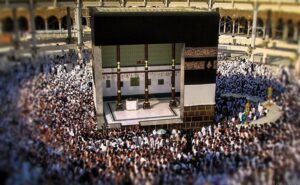

However, historical accounts and descriptions from those who have had the privilege of entering the Holy Kaaba suggest that its interior is relatively simple. It is believed to contain three pillars, a few lamps, and hooks used to hang religious artifacts and coverings.
The walls are reported to be plain and adorned with fabrics and Quranic verses. It is important to note that these details may vary over time due to renovations and maintenance.
Who can go inside the Holy Kaaba?
Access to the interior of the Holy Kaaba is highly restricted, and only a limited number of individuals are granted permission to enter. Generally, the custodians of the Holy Kaaba, whom the Saudi Arabian government appoints, have the authority to enter the Kaaba. These custodians, known as the Keepers of the Holy Kaaba, ensure the maintenance and cleanliness of the holy site.
There are also occasions when dignitaries or officials may be granted special access to the interior of the Holy Kaaba. However, such instances are infrequent and subject to specific circumstances and permissions. Usually, pilgrims cannot go inside the Kaaba during Hajj and Umrah.
What does the Holy Kaaba represent for Muslims?
The Holy Kaaba holds profound significance for Muslims. It represents the spiritual center of Islam and is considered the House of Allah. The Kaaba serves as a symbol of unity, devotion, and the oneness of Allah.
For Muslims, the Holy Kaaba is the direction they turn in during their prayers, no matter where they are. This act, known as Qibla, signifies the unity of the Muslim community, irrespective of geographical location or cultural differences.
The Holy Kaaba also plays a central role in the annual pilgrimage, Hajj, one of the Five Pillars of Islam. Millions of Muslims from diverse backgrounds gather in Mecca to perform rituals around the Kaaba during Hajj and Umrah.
The pilgrimage serves as a profound spiritual journey, emphasising humility, equality, and the unity of believers.
It also holds significance in Umrah. Umrah, often referred to as the lesser pilgrimage, holds great significance for Muslims worldwide. The Umrah pilgrimage involves visiting the holy city of Mecca and performing a series of rituals focused on the Kaaba.
Every year, countless Muslims embark on the spiritual journey of Umrah, seeking closeness to Allah and the opportunity to cleanse their souls. Umrah is distinct from Hajj in terms of its non-obligatory nature, allowing Muslims to undertake the pilgrimage at any time of the year. This is why, muslims can perform Umrah any time of the year.
The rituals of Umrah revolve around the Kaaba, the sacred centerpoint of Islam, which holds immense spiritual symbolism for believers. The rituals of Umrah, including the Tawaf (circumambulation) and Sa’i (running between the hills of Safa and Marwa), are performed with utmost devotion and reverence.
Muslims partake in Umrah to seek spiritual renewal, draw closer to their faith, and experience the profound sense of unity that arises from joining fellow believers in this sacred journey to the Kaaba.
Other nearby holy places
In addition to the Kaaba, Mecca is home to several other holy places that hold significance in Islam. One notable site is the Masjid al-Haram, the Grand Mosque, which encompasses the Kaaba itself.
It is the largest mosque in the world and serves as a gathering place for Muslims during their pilgrimage and throughout the year. Another important site is the Well of Zamzam, located near the Holy Kaaba, which is believed to have provided water to the Prophet Ismail and his mother, Hajar. The hills of Safa and Marwa, where the Sa’i ritual is performed, are also considered sacred.
Black Stone
The Black Stone, known as “Al-Hajar al-Aswad” in Arabic, is a revered relic located in the east corner of the Kaaba. It is a smooth black stone that holds great significance in Islamic tradition.
Muslims believe that the Black Stone was sent down from heaven as a sign of the location of the Kaaba during its construction by the Prophet Ibrahim (AS) and Ismail (AS).
Pilgrims who perform the Tawaf ritual during Hajj or Umrah often strive to touch or kiss the Black Stone in the east corner as an act of devotion and to seek blessings.
It is considered a sacred object and a symbol of the unity and faith of the Muslim community.
Masjid Al Haram
Masjid Al Haram, also called the Grand Mosque, is located in Mecca, Saudi Arabia, where the Holy Kaaba is. Masjid Al Haram is the largest mosque in the world, capable of accommodating millions of worshippers during the peak times of Hajj and Umrah pilgrimages.
Umrah Packages have various packages available for pilgrims to visit the Holy Kaaba here.
The mosque holds a prominent place in Islamic history and serves as the focal point for Muslims’ prayers. It features several notable architectural elements, including the towering clock tower, known as the Abraj Al-Bait, which has become an iconic symbol of Mecca.
The mosque also houses the Black Stone in its eastern corner, which holds great value for Muslims.
Al Muallaa Cemetery (Jannat al-Mu’alla)
Al Muallaa Cemetery, also known as Jannat al-Mu’alla, is an important cemetery located in Mecca, Saudi Arabia. It holds immense historical and cultural significance for Muslims.
It is the final resting place of several prominent figures, including the Prophet Muhammad PBUH’s wife, Khadijah, and many of his companions, such as Abu Talib and Abdullah ibn Abbas.
The cemetery holds a special place in Islamic history, reflecting the close connection between the early Muslim community and Mecca. It serves as a reminder of the legacy and contributions of the Prophet Muhammad PBUH and his companions.
Exhibition of the two holy mosques’ architecture
The Exhibition of the Two Holy Mosques’ Architecture is an educational and informative display showcasing the architectural features and development of Masjid Al Haram in Mecca and Masjid an-Nabawi in Medina. The exhibition aims to provide visitors with insights into the history, design, and expansion of these two important mosques.
The exhibition highlights the evolution of the mosques’ architecture over time, starting from their humble beginnings to their current grand scale. It showcases various aspects, including the intricate detailing, designs, materials used, and technological advancements employed in their construction.
Summary – Why is the Kaaba important to Muslims
To sum it up, the Holy Kaaba is important to Muslims due to its historical and religious significance. It is believed to be the first house of worship dedicated to Allah, built by Prophet Ibrahim (AS) and his son Ismail (AS).
Muslims face the Kaaba during prayers, symbolising unity and the oneness of Allah. It is also the central site for the annual pilgrimage, Hajj, and Umrah, fostering a sense of community and reinforcing faith among Muslims


